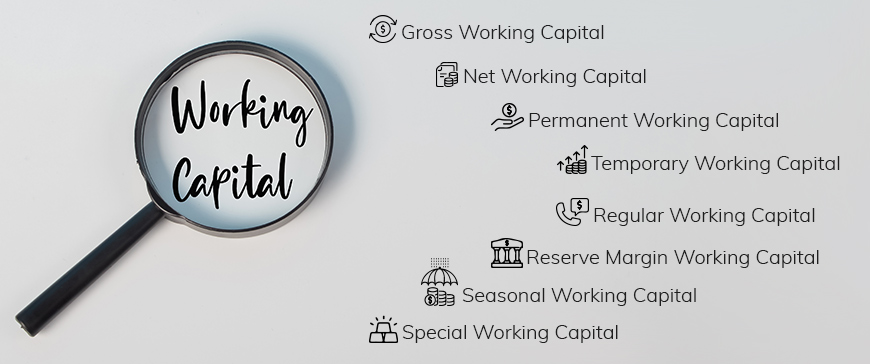A company must maintain an appropriate amount of working capital to stay in business. Working capital is one of the most crucial aspects of any business. If a company lacks enough working capital to meet its day-to-day expenses, it cannot focus on business expansion. There are several types of working capital, each with its own function.
On the other hand, working capital may cause higher business costs if it is excessive. A lack of working capital results in a lack of resources. Working capital management is crucial in this area. It has several adverse effects on the company’s profitability and liquidity, so you must decide how much working capital is required and how it can be financed.
In order to guarantee that your business’s operating capital is sufficient to meet its short-term liabilities, you must maintain adequate working capital. Working capital has many different types, and in this post, we will discuss some advice on managing it.
What is Working Capital?
A firm’s working capital is the number of current assets that exceed its current liabilities. Working capital is part of a firm’s overall capital. It is required to pay for the firm’s current obligations. Working capital indicates efficiency in managing an operation, especially if it is at an optimal level. It enables firms to pay for their day-to-day operating expenses and short-term debts.
Different Types of Working Capital

There are different types of working capitals. These are:
Gross Working Capital
This form of capital is a company’s asset investment that can be easily converted into cash. Stocks and other liquid assets may fall within this group.
Net Working Capital
A company’s liquidity is shown by its net working capital, which is the difference between current assets and liabilities. Working capital, or net working capital, is a measure of a company’s ability to meet its immediate financial obligations.
Permanent Working Capital
This is the minimal sum of money, which must be in cash or current assets, necessary to cover all current liabilities. It is commonly known as “fixed working capital.” The quantity of fixed capital a business needs will vary based on its size and rate of expansion. The more the business, the greater the requirement for fixed or long-term working capital.
Temporary Working Capital
The distinction between net working capital and permanent working capital is sometimes known as “variable, fluctuating, or cyclical working capital.”
Regular Working Capital
This is the smallest amount of capital necessary to cover on-going operating costs under typical circumstances. Salary and payroll payments, materials and supplies, and overhead expenses are a few examples of this capital.
Reserve Margin Working Capital
This kind of working capital can be compared to a “safety cushion.” The amount laid aside for “rainy day” situations like natural disasters, strikes, layoffs, or inflation is represented by this figure.
Seasonal Working Capital
This type of working capital includes the additional sum a firm requires to function during the peak season, which is related to the seasonal demand for items. It may also be thought of as a flexible form of operating capital.
Special Working Capital
This is categorized as temporary working capital used for unanticipated or extraordinary events like accidents, marketing or advertising initiatives, or new product development projects. This is an additional form of flexible working capital.
Working Capital Formula
It refers to the liquidity, efficiency, and short-term financial strength of the enterprise’s working capital. Working capital is a measurement of whether a business has the right amount of working capital.
Working capital is calculated by the equation, current assets minus current liabilities. It is calculated by this method:
Current Assets (CA) – Current Liabilities (CL) = Working Capital (WC)
It is important to understand what forms current assets and current liabilities for a business in order to understand the above equation.
Components of Working Capital
Current Assets: These assets can be readily converted into cash within a year or the company’s standard operating period, whichever is longer, and include: Cash and cash equivalents, Inventory Accounts Receivable, Marketable securities, Prepaid expenses, and Other liquid assets.
Current Liabilities: Current liabilities are the accountability of the business that are due within one operating period or a year, whichever is longer. They are paid off either with the company’s current assets or with additional current liabilities. Accounts Payable, Notes payable, Current portion of long-term debt, Accrued liabilities, and unearned revenues are a few current liabilities.
Working Capital Cycle
The working capital cycle is the time it takes for a company to turn its net working capital into cash. This includes the time it takes for a company to pay for raw materials and transform them into finished products, and then sell those finished products to customers. It is also called the “Cash Conversion Cycle,”.
The working capital cycle is a vital part of the financial health of a company. It can also help you determine whether the company has enough cash on hand to fund its growth plans and pay its bills.
Working capital loan
Working capital loans are short-term line of credit loan that allows businesses to borrow money that they can use to pay for day-to-day operational expenses. This type of loan is typically used to cover ongoing costs like payroll and inventory or to help the company make purchases it needs for its daily operations.
Advantages of working capital loans:
- You don’t have to use your personal assets as collateral.
- You can get the required money quickly.
- Easy to apply for and get approved.
Factors determining Working Capital
- A business’s need for working cash is greatly influenced by the type and size of the company. Manufacturing companies need operating cash in amounts ranging from minor to significant. The quantity of working capital a company needs depends on the kind of business it is in.
- Public utility companies have a similar balance between low working capital needs and high fixed-asset investments. Additionally, the company’s amount of working capital depends on its size. Larger businesses require more working capital than smaller businesses do.
- The need for working capital by a corporation is also significantly influenced by the business cycle. Businesses often expand during the boom phase of the business cycle, necessitating more working capital. Additional cash is needed during the heightened economic activity to cover the time lag between collection and selling.
- The peak season causes raw material prices to rise and wages to rise. Therefore, additional funding is required to cover these operational costs.
- The gap in time between transforming raw materials into finished goods is known as the production cycle, often referred to as the operating cycle. This has a higher impact on a business’s need for operating cash.
- Certain industries operate on a seasonal basis. This indicates a prominent demand for their products during a particular time of the year. In such circumstances, raw material inventory must be obtained over a certain time.
Conclusion
Understanding the different types of working capital can help a firm develop and meet its long-term goals. Companies use working capital to fund the growth of their business by meeting the short and long-term liquid needs of the business. This is very useful in many ways to help drive revenues and profits.
Mynd Fintech enables you to automate payment collection, reducing the amount of administrative work your staff must handle while pursuing bills. Learn how Mynd Fintech can assist you with irregular or one-time payments.
FAQs
Q.1 How many types of working capital are there?
Ans. Working Capital is classified into 8 categories depending on the periodicity of the capital and its concept or application.
Q.2 How do we calculate working capital?
Ans. Working capital is calculated by the equation, current assets minus current liabilities. It is calculated in this fashion:
Current Assets – Current Liabilities = Working Capital.
Q.3 What is net working capital?
Ans. A company’s liquidity is shown by its net working capital, which is the difference between current assets and liabilities. Working capital, or net working capital, is a measure of a company’s ability to meet its immediate financial obligations.
Q.4 What is the difference between gross and net working capital?
Ans. Net working capital is a company’s current assets and current liabilities difference, whereas gross working capital is the total of all a company’s current assets.

